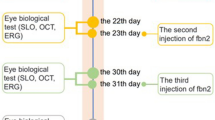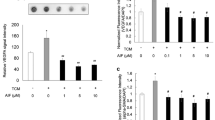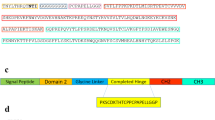Abstract
Accumulating evidence has shown the importance of vascular endothelial growth factor (VEGF) in chorioretinal angiogenesis. However, whether or not VEGF is indeed critical for the pathogenesis of subretinal neovascularization (SRN) in adulthood, which is a serious complication of age-related macular degeneration, has to be further investigated. We constructed an adenovirus expressing an entire ectodomain of the human VEGF receptor/flt-1 fused to Fc portion of human IgG (Adflt-ExR): this soluble receptor is secreted from Adflt-ExR-transfected cells. We studied the effect of Adflt-ExR on the formation of experimental SRN. Experimental SRN was induced by intense photocoagulation on the retina in pigmented rats and Adflt-ExR was injected into the femoral muscle. The formation of SRN assessed by fluorescein angiography was more significantly inhibited for 7 days in the Adflt-ExR-treated rats than in the control rats who received either an adenovirus vector encoding LacZ gene or balanced salt solution (BSS). The serum concentration of this soluble receptor increased for 7 days and thereafter gradually decreased. An immunohistochemical study disclosed the fibroblast cell proliferation and inflammatory cell infiltration to be reduced in the photocoagulation spot of Adflt-ExR-treated rats. VEGF plays a crucial role in the formation of SRN and VEGF soluble receptor gene transfection can inhibit SRN. This method will contribute to future gene therapy for age-related macular degeneration.
This is a preview of subscription content, access via your institution
Access options
Subscribe to this journal
Receive 12 print issues and online access
$259.00 per year
only $21.58 per issue
Buy this article
- Purchase on Springer Link
- Instant access to full article PDF
Prices may be subject to local taxes which are calculated during checkout






Similar content being viewed by others
References
Ghafour IM, Allan D, Foulds WS . Common causes of blindness and visual handicap in the west of Scotland Br J Ophthalmol 1983 67: 209–213
Ryan SJ, Stout JT, Dugel PU . Subretinal neovascularization. In: SJ Ryan (ed) The Retina vol 2: Mosby: St Louis 1994 pp 1027–1047
Kvanta A, Algvere PV, Berglin L, Seregard S . Subfoveal fibrovascular membranes in age-related macular degeneration express vascular endothelial growth factor Invest Ophthalmol Vis Sci 1996 37: 1929–1934
Aiello LP et al. Vascular endothelial growth factor in ocular fluid of patients with diabetic retinopathy and other retinal disorders New Engl J Med 1994 331: 1480–1487
Lopez PF et al. Transdifferentiated retinal pigment epithelial cell are immunoreactive for vascular endothelial growth factor in surgically excised age-related macular degeneration-related choroidal neovascular membranes Invest Ophthalmol Vis Sci 1996 37: 855–868
Ishibashi T et al. Expression of vascular endothelial growth factor in experimental choroidal neovascularization Graefe's Arch Clin Exp Ophthalmol 1997 235: 159–167
Sakamoto T et al. Effect of tecogalan sodium on angiogenesis in vitro by choroidal endothelial cells Invest Ophthalmol Vis Sci 1995 36: 1076–1083
Lopez PF et al. Transdifferentiated retinal pigment epithelial cells are immunoreactive for vascular endothelial growth factor in surgically excised age-related macular degeneration-related choroidal neovascular membranes Invest Ophthalmol Vis Sci 1996 37: 855–868
Tobe T, Takahashi K, Ohkuma H, Uyama M . Experimental choroidal neovascularization in the rat J Jpn Ophthalmol Soc 1994 98: 837–845
Dobi TE, Puliafito AC, Dwetro M . A new model of experimental choroidal neovascularization in the rat Arch Ophthalmol 1989 107: 264–269
Frank NR, Das A, Weber ML . A model of subretinal neovascularization in the pigmented rat Curr Eye Res 1989 8: 239–247
Ferrara N et al. Heterozygous embryonic lethality induced by targeted inactivation of the VEGF gene Nature 1996 380: 439–442
Okamoto N et al. Transgenic mice with increased expression of vascular endothelial growth factor in the retina: a new model of intraretinal and subretinal neovascularization Am J Pathol 1997 151: 281–291
Borgström P, Hillan KJ, Sriramarao P, Ferrara N . Complete inhibition of angiogenesis and growth of microtumors by anti-vascular endothelial growth factor neutralizing antibody: novel concepts of angiostatic therapy from intravital videomicroscopy Cancer Res 1996 56: 4032–4039
Shibuya M et al. Possible involvement of VEGF-FLT tyrosine kinase receptor system in normal and tumor angiogenesis Princess Takamatsu Symposia 1994 24: 162–170
Breier G, Clauss M, Risau W . Coordinate expression of vascular endothelial growth factor receptor-1 (flt-1) and its ligand suggests a paracrine regulation of murine vascular development Dev Dynam 1995 204: 228–239
Takahashi T, Shibuya M . The 230kDa mature form of KDR/Flk-1 (VEGF receptor-2) activates the PLC-γ pathway and partially induces mitotic signals in NIH3T3 fibroblasts Oncogene 1997 14: 2079–2089
Aiello LP et al. Suppression of retinal neovascularization in vivo by inhibition of vascular endothelial growth factor (VEGF) using soluble VEGF-receptor chimeric proteins Proc Natl Acad Sci USA 1995 92: 10457–10461
Anderson WF . Human gene therapy Science 1992 256: 808–813
Ogata N et al. Expression of basic fibroblast growth factor mRNA in developing choroidal neovascularization Curr Eye Res 1996 15: 1008–1018
Zhang NL, Samadani EE, Frank RN . Mitogenesis and retinal pigment epithelial cell antigen expression in the rat after krypton laser photocoagulation Invest Ophthalmol Vis Sci 1993 34: 2412–2424
Takehana Y et al. Suppression of laser-induced choroidal neovascularization by oral tranilast in the rat Invest Ophthalmol Vis Sci 1999 40: 459–466
Guerrin M et al. Vasculotropin/vascular endothelial growth factor is an autocrine growth factor for human retinal pigment epithelial cells cultured in vitro J Cell Physiol 1995 164: 385–394
Ferrara N et al. Vascular endothelial growth factor is essential for corpus luteum angiogenesis Nature Med 1998 4: 336–340
Sakamoto T et al. Retinal functional change caused by anadenoviral vector-mediated transfection of LacZ gene Hum GeneTher 1998 9: 789–799
Ueno H et al. Quantitative analysis of repeat adenovirus-mediated gene transfer into injured canine femoral arteries Arterioscl Thromb Vasc Biol 1995 15: 2246–2253
Fukushima M, Nakashima Y, Sueishi K . Thrombin enhances release of tissue plasminogen activator from bovine corneal endothelial cells Invest Ophthalmol Vis Sci 1989 30: 1576–1583
Yoshimura N et al. Photocoagulated human retinal pigment epithelial cells produce an inhibitor of vascular endothelial cell proliferation Invest Ophthalmol Vis Sci 1995 36: 1686–1691
Acknowledgements
This work was supported by Grants-in-Aid for Scientific Research from Ministry of Education, Science and Culture of the Japanese Government, and by the grants from Japan National Society for the Prevention of Blindness (Tokyo, Japan), from the Fukuoka Anti-Cancer Association (Fukuoka, Japan), from Kaibara Morikazu Medical Science Promotion Foundation (Fukuoka, Japan), from the Casio Science Promotion Foundation (Tokyo, Japan), and from Takeda Medical Research Foundation, from Tokyo Biochemical Society and the Health Sciences Research Grants Japan.
Author information
Authors and Affiliations
Rights and permissions
About this article
Cite this article
Honda, M., Sakamoto, T., Ishibashi, T. et al. Experimental subretinal neovascularization is inhibited by adenovirus-mediated soluble VEGF/flt-1 receptor gene transfection: a role of VEGF and possible treatment for SRN in age-related macular degeneration. Gene Ther 7, 978–985 (2000). https://doi.org/10.1038/sj.gt.3301203
Received:
Accepted:
Published:
Issue Date:
DOI: https://doi.org/10.1038/sj.gt.3301203
Keywords
This article is cited by
-
Gene transfer for ocular neovascularization and macular edema
Gene Therapy (2012)
-
Preclinical safety evaluation of subretinal AAV2.sFlt-1 in non-human primates
Gene Therapy (2012)
-
NSAIDs inhibit neovascularization of choroid through HO-1-dependent pathway
Laboratory Investigation (2011)
-
Microvascular Modifications in Diabetic Retinopathy
Current Diabetes Reports (2011)



